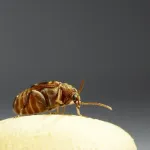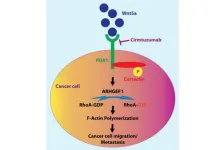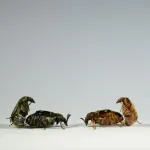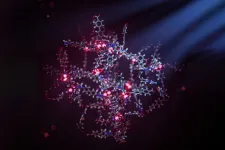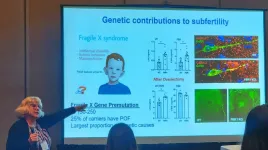(Press-News.org) Each year about 1.5 million people in the U.S. survive a traumatic brain injury due to a fall, car accident, or a sports injury, which can cause immediate and long-term disability.
University of Maryland School of Medicine (UMSOM) researchers wanted to better understand what happens in the brain during injury, so they conducted a study in mice to determine how different types of brain cells in mice react to severe trauma. In a new study published in the January issue of Autophagy, they found that after traumatic brain injury, the brain’s immune system cells’ internal recycling function slowed dramatically, allowing waste products to build up and interfere with recovery from injury.
The researchers also found that treating mice that had traumatic brain injury with a drug to promote cellular recycling improved the mice’s ability to recover from injury and solve a water maze, a measure of memory function in mice.
“Many drugs and potential solutions have been proposed to treat traumatic brain injury, but none have ever worked in practice,” said lead researcher Marta Lipinski, PhD, Associate Professor of Anesthesiology and Anatomy & Neurobiology at UMSOM and a member of the Shock, Trauma, and Anesthesiology Research (STAR) Center at the University of Maryland Medical Center (UMMC). “It could be that designing drugs for patients that promote this cellular recycling might reverse or prevent damage from traumatic brain injury as we saw in our animal studies. We are continuing to learn more about the molecular and cell biology mechanisms in trauma, so we can use a more guided approach for developing solutions.”
The body’s cells regularly recycle their own worn-out or damaged parts that accrue through normal wear and tear, infection, or injury in a process known as autophagy. Most cells in the brain use that process for cleaning up their own waste and recycling it on a smaller scale. In a previous study, Dr. Lipinski’s group showed that traumatic brain injury reduced the ability of neurons — the cells that send electrical impulses — to recycle their own damaged parts, which then led to these neurons dying off. However, some cells in the brain can perform greater feats of recycling, such as the resident immune cells in the brain known as microglia, which can engulf, digest, and recycle entire damaged or dead cells in the tissue.
After a traumatic brain injury, white blood cells—normally excluded by the blood-brain barrier — can also get into the brain and work alongside the microglia cells to eat and remove damaged cells. For this new study, Dr. Lipinski’s team focused on the immune cells — microglia and white blood cells — in the brain after traumatic brain injury and found that, like the neurons, their recycling function was also suppressed.
“Dr. Lipinski's discovery of the recycling function suppression in both neurons and immune cells demonstrates how important it is for neuroscientists to fully understand the complex system involved in a traumatic brain injury,” said Dean Mark Gladwin, MD, who is Vice President for Medical Affairs at the University of Maryland, Baltimore, and the John Z. and Akiko K. Bowers Distinguished Professor at UMSOM. “Developing effective drugs for traumatic brain injury treatment requires a deeper understanding of these cell-to-cell interactions and what impact each cell type has on the brain’s ecosystem.”
To demonstrate the full impact of the recycling process on traumatic brain injury and recovery, Dr. Lipinski and her team blocked one of the essential proteins needed to carry out the immune cell’s recycling function in the brains of mice with a brain injury. These mice experienced an even greater suppression of their cell recycling processes, resulting in more inflammation in their brain. They even performed worse, as measured by their ability to solve the water maze, than the mice with only brain injury. These findings suggested that the recycling function of the immune cells in the brain is essential for recovery after brain trauma. Conversely, boosting it may possibly lessen the impact of the trauma.
To test that, the researchers used a drug, rapamycin (normally used as a cancer drug or to prevent organ rejection), to promote cellular recycling in the brains of mice who had traumatic brain injury. The researchers found that with the treatment, the mice had lower levels of inflammation in the brain and these mice did better in navigating the water maze.
“The drug we used in our study blocks a set of proteins that are important for regenerating the body’s cells, so it cannot be used for extended time periods,” said Dr. Lipinski. “We need to continue this line of research to identify the exact mechanism of how autophagy protects against neurological damage in order to find more targeted drugs that increase this process without targeting the vital proteins needed by the brain to regenerate.”
This study was funded by grants from the National Institutes of Health’s National Institute of Neurological Disorders and Stroke (NINDS) (R01NS094527, R01NS091218, R01NS115876).
About the University of Maryland School of Medicine
Now in its third century, the University of Maryland School of Medicine was chartered in 1807 as the first public medical school in the United States. It continues today as one of the fastest growing, top-tier biomedical research enterprises in the world — with 46 academic departments, centers, institutes, and programs, and a faculty of more than 3,000 physicians, scientists, and allied health professionals, including members of the National Academy of Medicine and the National Academy of Sciences, and a distinguished two-time winner of the Albert E. Lasker Award in Medical Research. With an operating budget of more than $1.3 billion, the School of Medicine works closely in partnership with the University of Maryland Medical Center and Medical System to provide research-intensive, academic, and clinically based care for nearly 2 million patients each year. The School of Medicine has nearly $600 million in extramural funding, with most of its academic departments highly ranked among all medical schools in the nation in research funding. As one of the seven professional schools that make up the University of Maryland, Baltimore campus, the School of Medicine has a total population of nearly 9,000 faculty and staff, including 2,500 students, trainees, residents, and fellows. The combined School of Medicine and Medical System (“University of Maryland Medicine”) has an annual budget of over $6 billion and an economic impact of nearly $20 billion on the state and local community. The School of Medicine, which ranks as the 8th highest among public medical schools in research productivity (according to the Association of American Medical Colleges profile) is an innovator in translational medicine, with 606 active patents and 52 start-up companies. In the latest U.S. News & World Report ranking of the Best Medical Schools, published in 2021, the UM School of Medicine is ranked #9 among the 92 public medical schools in the U.S., and in the top 15 percent (#27) of all 192 public and private U.S. medical schools. The School of Medicine works locally, nationally, and globally, with research and treatment facilities in 36 countries around the world. Visit medschool.umaryland.edu
END
Traumatic brain injury interferes with immune system cells’ recycling process in brain cells
New finding indicates drug development targeted at promoting recycling could help lessen neurological symptoms and treat brain trauma
2023-04-04
ELSE PRESS RELEASES FROM THIS DATE:
Rats! Rodents seem to make the same logical errors humans do
2023-04-04
Animals, like humans, appear to be troubled by a Linda problem.
The famous “Linda problem” was designed by psychologists to illustrate how people fall prey to what is known as the conjunction fallacy: the incorrect reasoning that if two events sometimes occur in conjunction, they are more likely to occur together than either event is to occur alone.
Now, for the first time, UCLA psychology researchers have shown that this type of logical error isn’t the sole province of humans ...
Impact of cortactin in cancer progression
2023-04-04
“Cortactin (also known as EMS1 or CTTN) is expressed broadly in a variety of cancers [...]”
BUFFALO, NY- April 4, 2023 – A new editorial paper was published in Oncotarget's Volume 14 on March 21, 2023, entitled, “Impact of cortactin in cancer progression on Wnt5a/ROR1 signaling pathway.”
In this editorial, researchers Kamrul Hasan and Thomas J. Kipps from the University of California discuss cortactin—an intracellular cytoskeletal protein that can undergo tyrosine phosphorylation upon external stimulation and promote polymerization and the assembly of the actin filament that is required for cell migration. Upon stimulation, cortactin ...
Male beetles neglect their genomes when competing for females
2023-04-04
Male beetles face a trade-off between competing with other males for mating opportunities and repairing damage to their sperm DNA, according to a study publishing April 4th in the open access journal PLOS Biology by Mareike Koppik from Uppsala University, Sweden, and colleagues.
Mutations in sperm and egg DNA can reduce the survival and fitness of offspring, so animals use a variety of repair and maintenance mechanisms in their reproductive cells. However, previous research has shown that sperm DNA has more mutations than egg DNA in a variety of ...
Studies ask: what does “multimorbidity” mean and how much does it cost us?
2023-04-04
The prevalence of multimorbidity, the co-occurrence of two or more chronic conditions, varies depending on exactly how it is defined. And the healthcare costs associated with many disease combinations cost more together than the sum of each individual disease. Those are the conclusions of two new studies, publishing April 4th in the open access journal PLOS Medicine, that broadly analyze the concept and costs of multimorbidity.
Multimorbidity is increasing in prevalence due to improved survival from chronic diseases and population aging, and now poses major challenges to healthcare systems worldwide. ...
SCI Canada Awards event to showcase country’s diverse scientific talent from Nunavut to Ontario
2023-04-04
SCI Canada Awards 2023 dinner, seminar and presentations to take place on 18 April in Toronto
Seminar theme is ‘Unlocking the potential of science talent enabling impact on Canada’s economic growth’
Award winners include the first indigenous community members
Dr Paul Smith, Perimeter Institute for Theoretical Physics, will receive the 2023 Canada Medal
A panel representing the best of Canadian science and industry will discuss its role in boosting economic growth at a special awards event on 18 April in Toronto.
Winners of the 2023 SCI Canada Awards include ...
Scientists use computational modeling to design “ultrastable” materials
2023-04-04
CAMBRIDGE, MA -- Materials known as metal-organic frameworks (MOFs) have a rigid, cage-like structure that lends itself to a variety of applications, from gas storage to drug delivery. By changing the building blocks that go into the materials, or the way they are arranged, researchers can design MOFs suited to different uses.
However, not all possible MOF structures are stable enough to be deployed for applications such as catalyzing reactions or storing gases. To help researchers figure out which MOF structures might work best for a given application, MIT researchers have developed a computational approach that allows ...
Why do females prefer ornate male signals?
2023-04-04
Sexual selection provides an answer to the existence of lavishly ornate signals in animals, but not to the question of why such signals are attractive, why do females prefer the extravagant plumage of peacocks? As part of an international team, researchers at Eötvös Loránd University (ELTE) have shown that the reason is not the presumed wasteful cost of ornaments, as honest signals need not have to be costly at all as long as cheaters would have to pay to fake them. Researchers have developed a general formula to calculate honest equilibrium in any model, independent of the cost ...
How an autism gene contributes to infertility
2023-04-04
RIVERSIDE, Calif. -- A University of California, Riverside, study has identified the biological underpinnings of a reproductive disorder caused by the mutation of a gene. This gene mutation also causes Fragile X Syndrome, a leading genetic cause of intellectual impairment and autism.
The researchers found mutations of the Fragile X messenger ribonucleoprotein 1 gene, or FMR1, contribute to premature ovarian failure, or POF, due to changes in neurons that regulate reproduction in the brain and ovaries. The mutation has been associated with early infertility, due ...
Penn Medicine researchers develop model to predict cardiovascular risk among chronic kidney disease patients
2023-04-04
PHILADELPHIA — Chronic kidney disease (CKD) is a strong cardiovascular risk factor and is often accompanied by hypertension and diabetes. Despite the disease’s prevalence—10 percent of individuals across the globe suffer from CKD—there are limited tools for measuring cardiac risk for CKD patients, until now. A new proteomic risk model for cardiovascular disease was found to be more accurate than current methods of measuring cardiac risk, according to a new study led by researchers in the Perelman School of Medicine at the University of Pennsylvania. The study published today in the European Heart Journal.
The Penn researchers developed ...
Overwhelmed? Your astrocytes can help with that
2023-04-04
How Little-Known Brain Cells Tamp Down Overexcited Neurons During Acute Stress
A brimming inbox on Monday morning sets your head spinning. You take a moment to breathe and your mind clears enough to survey the emails one by one. This calming effect occurs thanks to a newly discovered brain circuit involving a lesser-known type of brain cell, the astrocyte. According to new research from UC San Francisco, astrocytes tune into and moderate the chatter between overactive neurons.
This new brain circuit, described March 30, 2023 in Nature Neuroscience, plays a role in modulating attention and perception, and may hold a key to treating attention disorders like ...
LAST 30 PRESS RELEASES:
Exploring how the visual system recovers following injury
Support for parents with infants at pediatric check-ups leads to better reading and math skills in elementary school
Kids’ behavioral health is a growing share of family health costs
Day & night: Cancer disrupts the brain’s natural rhythm
COVID-19 vaccination significantly reduces risk to pregnant women and baby
The role of vaccination in maternal and perinatal outcomes associated with COVID-19 in pregnancy
Mayo Clinic smartwatch system helps parents shorten and defuse children's severe tantrums early
Behavioral health spending spikes to 40% of all children’s health expenditures, nearly doubling in a decade
Digital cognitive behavioral treatment for generalized anxiety disorder
Expenditures for pediatric behavioral health care over time and estimated family financial burden
Air conditioning in nursing homes and mortality during extreme heat
The Alps to lose a record number of glaciers in the next decade
What makes a good proton conductor?
New science reporting guide published for journalists in Bulgaria
New international study reveals major survival gaps among children with cancer
New science reporting guide published for journalists in Turkey
Scientists develop a smarter mRNA therapy that knows which cells to target
Neuroanatomy-informed brain–machine hybrid intelligence for robust acoustic target detection
Eight SwRI hydrogen projects funded by ENERGYWERX
The Lundquist Institute and its start-up company Vitalex Biosciences Announces Strategic Advancement of Second-Generation fungal Vaccine VXV-01 through Phase 1 Trials under $40 Million Competitive Con
Fine particles in pollution are associated with early signs of autoimmune disease
Review article | Towards a Global Ground-Based Earth Observatory (GGBEO): Leveraging existing systems and networks
Penn and UMich create world’s smallest programmable, autonomous robots
Cleveland researchers launch first major study to address ‘hidden performance killer’ in athletes
To connect across politics, try saying what you oppose
Modulating key interaction prevents virus from entering cells
Project explores barriers to NHS career progression facing international medical graduates
Jeonbuk National University researchers explore the impact of different seasonings on the flavor perception of Doenjang soup
Two Keck Medicine of USC Hospitals named Leapfrog Top Teaching Hospitals
World-first discovery uncovers how glioblastoma tumours dodge chemotherapy, potentially opening the door to new treatments
[Press-News.org] Traumatic brain injury interferes with immune system cells’ recycling process in brain cellsNew finding indicates drug development targeted at promoting recycling could help lessen neurological symptoms and treat brain trauma

